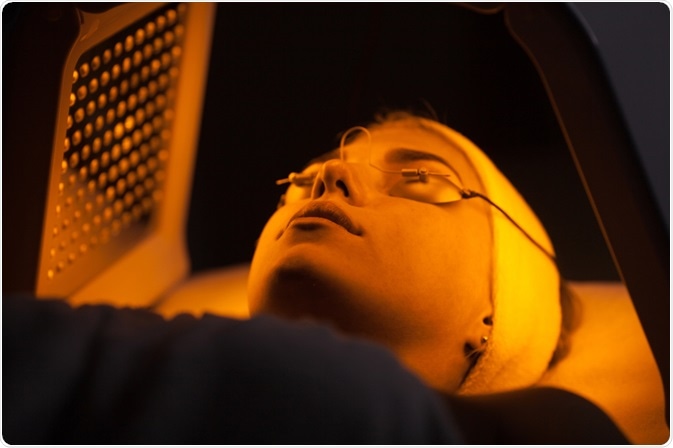Light emitting diode (LED) therapy is a treatment procedure that is widely used to treat various skin conditions. Unlike laser therapy that employs light waves at high energy, LED light therapy is gentle and safe. It has been used widely in dermatology clinics to treat many skin diseases.

LTim | Shutterstock
LED therapy has been used for decades. In fact, NASA used it in experiments on plant growth on the Space Shuttle in the 1980s. Now, the technology is widely used by dermatologists to treat various skin conditions. This type of therapy relies on colored wavelengths of light that can penetrate the skin surface.
How does LED therapy work?
Once the right wavelength of light from an LED is applied, it stimulates the cells to produce adenosine triphosphate (ATP), which is the energy form used by the cells of the body.
Fibroblast cells in the dermis of the skin use ATP to produce collagen and elastin; two important structures that maintain skin firmness and elasticity. Hence, by enhancing energy stores in the skin, LED therapy may stimulate the renewal of connective tissue and reduce the appearance of premature skin aging.
Which color of light is right for me?
The light colors used in LED therapy will depend on the particular skin condition. For instance, red LED light therapy stimulates cellular activity, and is used to trigger healing and produce collagen. Red light thus helps reduce the appearance of wrinkles and fine lines, combats sun damage, reduces stretch marks, and deals with redness.
Blue LED therapy, however, can be used to kill bacteria that cause acne and yellow LED light has been clinically proven to increase the overall health of the skin. Yellow light addresses skin problems, helps rejuvenate the skin, hastens wound healing, improves blood circulation to the skin tissues, and reduces signs of aging like fine lines or wrinkles.
Does LED therapy improve the condition of the skin?
LED light has been proven to improve the health of the skin, such as reducing the appearance of wrinkles, fine lines, and dark spots. It can also be useful in treating active acne and residual acne scars. LED therapy is also good for improving uneven skin tone, reducing the size of skin pores and so improving the fineness of the skin, rejuvenating the youthful glow of the skin, and brightening the skin.
Studies supporting LED therapy for dermatological applications
A study published in the Journal of Clinical and Aesthetic Dermatology, using LED light with frequencies of 415 nm (blue), 830 nm (infrared), and 633 nm (red), showed promising results for treating many medical conditions, including wound healing, psoriasis, acne vulgaris, basal cell carcinoma, squamous cell carcinoma in situ (Bowen’s disease), and actinic keratosis. LED therapy has also demonstrated significant positive results in cosmetic applications.
In another study published in the Journal of Cosmetic and Laser Therapy, it was shown that the use of LED light can promote skin rejuvenation. Moreover, the study concluded that LED therapy is safe, and is the only aesthetic device that can be used in all kinds of skin conditions since the contraindications are nil.
In short, LED light therapy has many applications in dermatology. It is a non-invasive, safe, and effective treatment procedure that is ideal for all skin types. With its safety and efficacy, it’s no wonder LED light therapy is emerging globally as a new skin treatment.
Further Reading